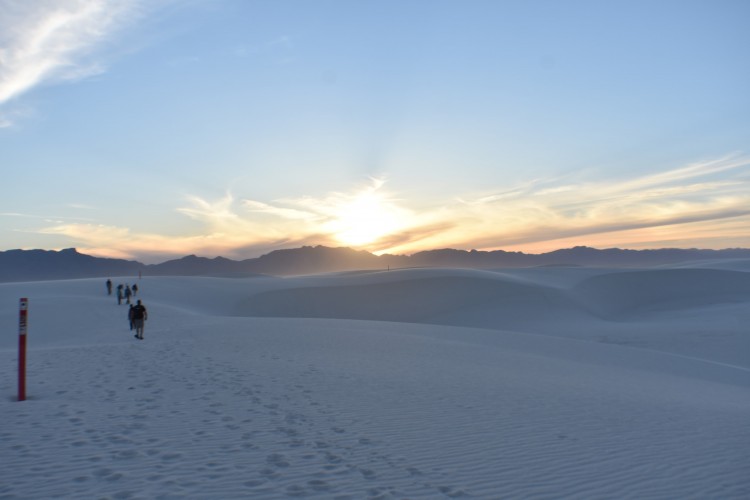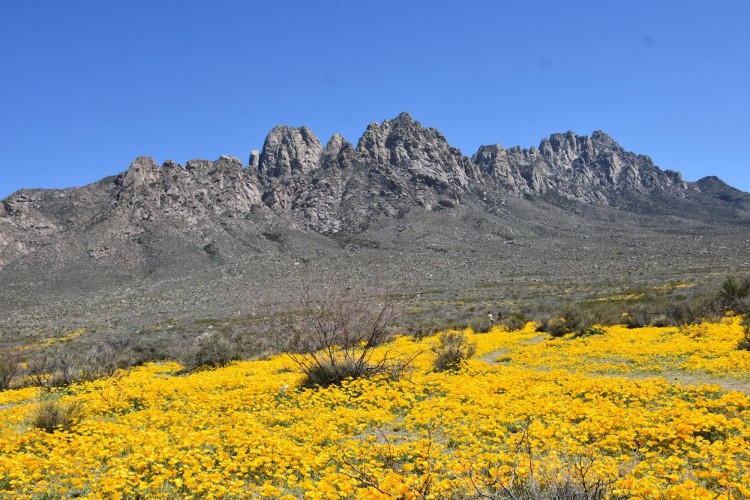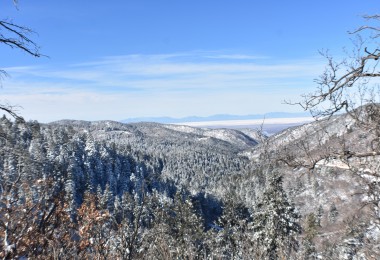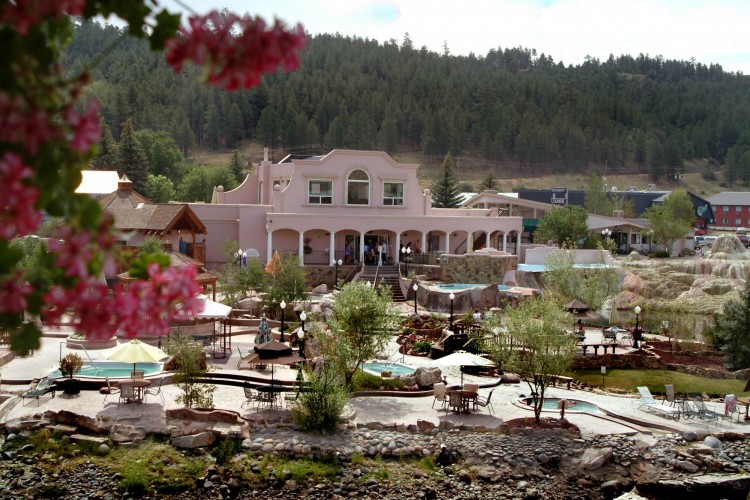Like all our national parks, White Sands National Park in Alamogordo, NM, is worth the trip. Located along US-70, this extraordinary park was the deal breaker for our decision on where to retire. Happily, we live 13 miles away and visit as often as possible.
From November through March, we can sandshoe White Sands National Park (WSNP) on Saturday, then snowshoe the Osha trail, located 45 minutes up-mountain from Cloudcroft, on Sunday.
Setting the Stage for Sandshoeing
Our sandshoeing distance is 5k, and our surface sand is gypsum. We have some soft, packed sand, never any water but several high and mighty dunes. So, we amped up our workouts and sandshoed, starting with a 1-mile trip and gradually adding miles to this fun new sport.
We captured our experiences in several: my husband Darrel took lots of pictures, and I talked about what we were seeing, doing, and experiencing into a voice recorder on my phone. I use Samsung Voice Recorder, a free app. There are many apps to choose from, so choose what’s best for you.
Read More: Photography on Trail: Make Memories With Beginner Outdoor Photo Tips
White Sands Sandshoe Trails
My husband Darrel and I are avid hikers and well acquainted with the Alkali Flats Trail, a singularly unique trail, dunes galore, and five-miler at White Sands. We try to hike this trail on the night of the full moon at least six times per year, May through October. We encourage everyone to try out this trail or one of several others when the moon is full.
The Playa trail, an easy 0.5-mile loop, includes outdoor exhibits and diagrams that showcase what the area looked like 10,000 years ago, including the gigantic animals that once roamed here.
Interdune Boardwalk is a 0.4-mile trail that is wheelchair accessible. The ten exhibits along the way tell of the tenacity of wildlife living in this harsh environment now.
Dune Life Nature Trail, 1mile, and Backcountry Camping Trail, 2 miles, both include steep dunes.
First-time visitors to WSNP are advised to consult with rangers at the visitor center before heading out, as conditions are wildly different than other hiking situations. However, those who do will be rewarded with a thoroughly enchanting New Mexico true experience.
Read More: Cloudcroft, New Mexico: Snowshoe Gem of the Southwest
Our Incomparable Full Moon
2021 brought us a full moon on May 26, The Flower Moon, June 24, the Strawberry Moon, July 23, the Bucks Moon, August 22, the Sturgeon Moon, September 20, the Harvest Moon, and on October 20, the Hunters Moon.
These full moons are so named by ancient cultures worldwide based on the behavior of crops and plants, wildlife and weather during that month. Colonial Americans likely adopted the names above from their Native American names. For instance, Strawberry Moon comes from the Algonquin reference to a short harvesting season when strawberries produce. Likewise, the September Moon, Harvest, refers to the last full moon before seasons change, a time for the final harvesting of crops.
We get on the Alkali trail early, before sunset, which heightens the beauty and drama of our outing. This way, we’re treated to a fantastic view of the sun as it slowly sinks behind the San Andreas Mountains, igniting the sky. A flaming sunset blazes across the mountaintops, resting in a final glow upon the dunes.
We’re careful not to step off the trail as our dunes are not sand but a rare form of crystallized gypsum that dates back about 250 million years ago to an ancient shallow sea. This gypsum is rare because it would typically have dissolved and washed down to the ocean. But here in the Chihuahuan desert, our dune field is in a basin, which traps the mineral as water evaporates, leaving sparkling gypsum blocks and spikes of crystal.
Wind and weather break these crystals down, creating the largest gypsum dune field in the world, a glittering 275 square miles of purest white “sand,” quite literally like no other place on earth. Visible from outer space, NASA’s Earth Observing 1 satellite photographed this gigantic dune field (WSNP encompasses 46%). View these pictures, and explore the history and geography of this otherworldly place at NASA’s Visible Earth.
Read More: Try Your Snowshoes on Sand and Go Sandshoeing

The Alkali Flats trail is one of the most popular and perfect for a full moon hike. Photo: Darrel Heller
Sights near White Sands National Park
After sandshoeing or snowshoeing in White Sands National Park, feel free to check out the beautiful sights around the area.
Mesilla
There are plenty of accommodation and eatery options in Alamogordo itself, in addition to the beautiful trails, parks, and the best climate. However, for this adventure, we’d recommend Mesilla, in Las Cruces, New Mexico, as your resting point.
You’ll step into another time and place in Mesilla, about an hour southwest of White Sands. The area was once a part of Mexico and still retains its charm, color, and culture. Mesilla Plaza, a National Historic Landmark, is much the same as 100 years ago when its resident buildings were designed to protect its people from frequent attacks.
These authentic adobe structures now house art galleries, restaurants, museums, and shopping opportunities. Allow one hour to step inside the historic Basilica San Albino Catholic Church, built in Mexico in 1852, before this territory was transferred to the U.S. The Basilica is one of the oldest churches in the region and still offers services.
Within minutes of the plaza, you can also visit vineyards and pecan orchards. Our favorite is Heart of the Desert Pistachios and Wines. We also like Double Eagle Restaurant on the plaza, (575) 523-6700), an ornately decorated, antique rich old hacienda. If you enjoy an alcoholic beverage, do not skip the margaritas here!
Also, shop at New Mexico Vintage Market before quitting the day. Accommodations abound in Mesilla and Las Cruces, but we like to “stay in this moment back in time.” So, for that reason, we’d recommend Hacienda de Mesilla, (575) 525-4300, or Josefine’s Old Gate, (575) 888-4791, both most charming.

The scenic drive features super bloom poppies along San Augustin Pass, through the Organ Mountains. Photo: Darrel Heller
Scenic Drive
On your drive from White Sands National Park to Mesilla, US-70 offers a beautiful scenic drive. On the way, you’ll pass White Sands Missile Range, a military testing area operated by the U.S Army, and you might see Oryx grazing on the range during the drive.
You’ll continue this best-looking approach across the Organ Mountains, through San Augustin Pass, and into Las Cruces. The Organ Mountains-Desert Peaks National Monument also offers an excellent reason to plan an extra day of hiking in the area.
Trinity Site
On July 16, 1945, the world’s first atomic bomb was detonated 60 miles north of White Sands National Park. As they say, “The rest is history.”
The detonation’s cloud rose 38,000 feet into the air, forming a one-half mile wide by eight feet deep crater. Its intense heat turned the sand into a green glass-like substance we’ve called trinitite, ground zero – Trinity Site. A monument was erected in 1965 and designated a National Historic Landmark in 1975. For information and tours, call Alamogordo Chamber of Commerce at 1 (800) 826-0294.
We found a whole new outdoor “keeper” of a sport and another reason to visit White Sands National Monument. Hope to see you there! What about you? Have you been sandshoeing or snowshoeing near White Sands National Park? Please share your insights in the comments below.
This article was first published on August 22, 2021, and was most recently updated on August 25, 2022.
Read Next: Snowshoe New Mexico: Where to Go in the Land of Enchantment












Thanks for joining the Sandshoe Revolution !
Great article .. Makes me want to head down to the beach tonight .
Thanks, Bob! I’m glad you enjoyed the article, and I hope you’ve had some great sandshoeing adventures! -Susan, Snowshoe Mag Editor